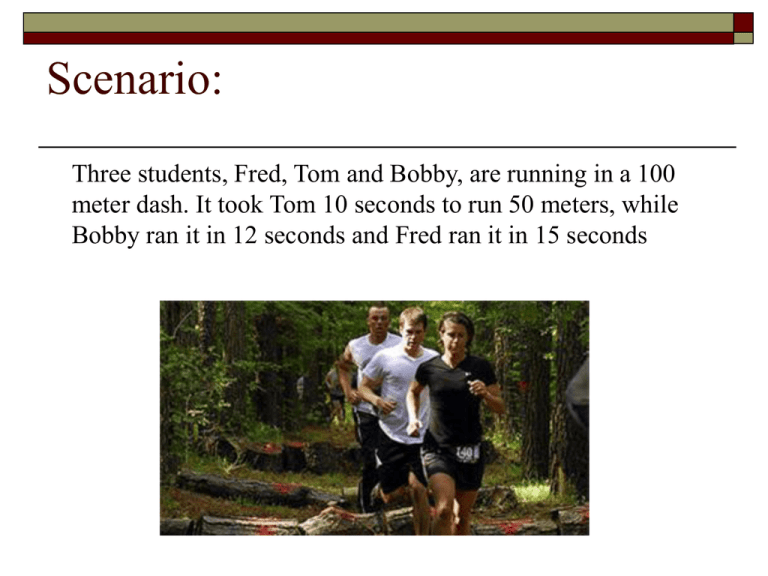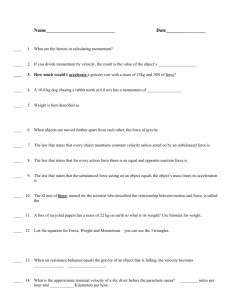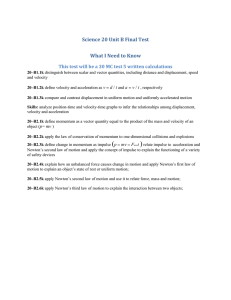Force and Newton's First Law
advertisement

Scenario: Three students, Fred, Tom and Bobby, are running in a 100 meter dash. It took Tom 10 seconds to run 50 meters, while Bobby ran it in 12 seconds and Fred ran it in 15 seconds Think --- Pair --- Share Which student is running slower? Which student will probably win the race? Could another student still win the race? Explain. What are some other everyday examples of speed, velocity and acceleration? Activity Ball’s trip to the Wall Distance (centimeters) Time (seconds) Speed Forward or Backward? Velocity (+,-) Speed Forward or Backward? Velocity (+,-) Ball’s trip from the Wall Distance (centimeters) Time (seconds) Physics the study of the relationship between matter and energy Motion A change in position in a certain amount of time Motion is relative. To know you are moving, you must have a reference point Distance – how far you traveled Units for distance?? Distance vs. Displacement The distance between the final position and starting position is displacement (Ex: hiking on a trail. The trail may be 1 mile long but you may only end up 300 ft from where you started) Speed Equation Speed – the distance traveled divided by the time needed to travel that distance SI Unit is meters per second (m/s) Other Units? Speed = distance time D S T Practice (Make sure you use the proper units) If it takes you 3 hours to travel 60 miles, what is your speed?? If you are running 3 miles in 30 minutes, what is your speed? Constant speed vs. Average speed Constant speed – an object covers equal distances in equal amounts of time The speed of moving objects is not always constant Average speed: total distance total time Graphing Speed Draw the Following Graph Velocity Velocity: Speed in a given direction You can be going the same speed but two different velocities Velocity = distance + direction time D V T Acceleration The change in velocity divided by the time the change occurs A = Velocity(final) – Velocity(initial) Time Acceleration is speeding up, slowing down or changing direction Stop Here!!! Day Two – Force!!! Force A force is a push or pull exerted on an object Force is measured in Newtons (kg m/s2) In order for an object to speed up, slow down or change direction, a force has to act on that object Inertia is the object’s tendency to resist changing its motion. The more inertia, the harder it is to start moving or slow it down Total Force Forces almost always act in pairs with one force acting on either side of the object The resulting force that exists between two is the net force Balanced Forces Balanced forces exist when the total force is equal to zero. Balanced forces do not change an object’s motion Unbalanced Forces When a net force acts on an object, they are said to be unbalanced. Unbalanced forces can cause an object to start moving, stop moving, or change direction. 225 N Net Force Unbalanced 225 N 50 N 100 N 50 N 100 N Net Force Balanced 0N 792 N 632 N 100 N 1524 N Net Force Unbalanced 400 N 900 N 224 N Friction and Air Resistance Friction is the force between two objects in contact that resists motion between two touching surfaces It is what eventually causes things to slow down and stop Air Resistance is a form of friction between an object and air molecules Gravity Gravity is the pull that all matter exerts on other matter Gravity is dependent on the mass of an object and the distance between the two objects The greater the mass, the more gravitational pull it will have (i.e.: earth vs. moon) The greater the distance, the less gravitational pull it will have Mass vs Weight – weight is the amount of gravitational pull on a person. So on the moon, your mass would be the same but weight would be different Free Fall and Terminal Velocity When the only force acting on an object is gravity, the object is said to be in free fall On earth, this is 9.8 m/s2 - Gravity constant In the absence of air resistance, all objects on Earth accelerate at the same rate, regardless of their mass. An object reaches its terminal velocity when the force of gravity is balanced by the force of air resistance Tuesday, November 9 Objective: Students will be able to: Practice problems about What are Force and Motion you learning 1. Worksheet on Force and Motion today? 2. Brainstorm ideas for project Warm Up Read the following: Things to do: Sir Isaac Newton (4 January 1643 – 31 March 1727)was an English physicist, mathematician, astronomer, natural philosopher, alchemist, and theologian, and is considered by many scholars and members of the general public to be one of the more influential people in human history. His Philosophiæ Naturalis Principia Mathematica (Latin for "Mathematical Principles Of Natural Philosophy"; usually called the Principia), published in 1687, is probably the most important scientific book ever written. It lays the groundwork for most of classical mechanics. In this work, Newton described universal gravitation and the three laws of motion, which dominated the scientific view of the physical universe for the next three centuries. Take out your notebook Newton’s Laws Newton’s First Law of Motion “An object at rest will remain at rest and an object in motion will maintain its velocity unless it experiences an unbalanced force.” This is often times called the law of Inertia Newton’s Second Law of Motion “The unbalanced force acting on an object equals the object’s mass times its acceleration” F=ma Force is measured in Newtons (kg m/s2) Newton’s Third Law For every action force, there is an equal and opposite reaction force In your notebook…. Draw or explain an example of each of Newton’s 3 Laws. Gravity Demo Warm Up 11/16 Write Q&A How much time does it take for a snail to crawl 20 feet if he goes 2 feet/hr Make sure you have turned in your speed problems worksheet!!! Warm Up 11/11 Get a calculator and begin calculate your speeds for the 4 activities Remember: Speed = Distance/Time Round everything to the nearest hundreths (ex. 5.45s) Make sure and list your units in your answers Warm Up 11/13 What is the formula for finding speed? What is the formula for finding distance? What is the formula for finding time? Remember 2nd Law: F=MA Warm Up 11/10 Write Q&A What is speed? How do you calculate it? Warm Up 11/4 Write Q&A Write an example of something that goes along with each of Newton’s Laws Ex 1st - A car will sit at a stoplight until you press the gas 2nd - It is harder to carry a box of rocks than a box of popcorn 3rd - When birds fly, they push their wings down in order to go up Warm Up 11/4 List 5 Examples of motion that you see in your everyday activities Rubric for Project Newton’s Laws Clips – 60 points total Video Clip – 10 points Description – 5 points Does it fit law? – 5 points Presentation – 15 points Did all participate – 15 points Creativity – 10 points Wednesday, November 10 Objective: Students will be able to: demonstrate the everyday What are occurrences of Newton’s 3 laws you learning 1. Video Project today? You must have 3 video clips by the end of the class period!! Warm Up Answer the following: Describe your interaction with one of Newton’s 3 laws in the last couple of days Find Things to do: a partner Look at your drawings of the 3 laws from Monday Monday, November 1 Objective: Students will be able to: Review the basics of the What are principles of Motion you learning 1. Look at questions from Chemistry Test today? 2. Notes on Motion Warm Up Answer the following: (Start a new section) What evidence do you use to tell if you are in motion or not? Glue Things to do: the notes into your spiral






